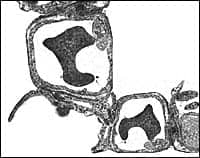RTs at NCMC participate in a protocols-driven consult service that has improved patient and staff satisfaction.
Most respiratory therapy departments have established therapist-driven protocols, but a consult service that is initiated for every patient ordered to receive respiratory therapy is a relatively recent concept that has yet to be perfected. One facility that is leading the way in respiratory therapy consult-service implementation can be found nestled in Greeley, Colo, a relatively rural area that is expanding as the population increases. Much as the city is moving forward, the facility supporting the area, the North Colorado Medical Center (NCMC), is also advancing and becoming distinguished as a leading respiratory care facility.
 |
|
Tod Cunningham, RRT, (at left) the respiratory care clinical supervisor, leads the team in one of their daily “ten o’clock” meetings to discuss patient care issues, policy updates, and educational topics. |
The 300-bed facility at NCMC is a regional referral area for northeastern Colorado that includes a level II trauma center, a burn unit, a level II nursery, inpatient respiratory services, neurodiagnostics, outpatient pulmonary services, and a sleep laboratory. The respiratory department at NCMC is firmly embedded in the system, and the staff of about 50 employees sees the full spectrum of pulmonary and critical care medicine.
The success of the department hinges on two components—forward-looking leadership and an organized staff of respiratory therapists with a high level of responsibility and autonomy. “Basically, it is the people in the department that make it so good, and it is a willingness to try to do the right thing for the patient that has allowed us to do a lot of different things,” says Michael Schwartz, MD, medical director of respiratory care and medical director of the respiratory special care unit at NCMC. “If we see an article that has evidence supporting the use of something, we will try it if we think it makes sense and fits the needs of the patient.”
Directors at NCMC are known for staying current with trends in respiratory therapy, and, as pieces of evidence that supported consult services surfaced, they realized the necessity for such a program within their facility. The consult service at NCMC took root in 1996 with the implementation of therapist-driven weaning protocols and began to broadcast out into the hospital from there. Schwartz says that there was a lot of good information coming out of Cleveland Clinic. “We looked at how we could improve outcomes, improve patient/customer satisfaction, shorten length of stay, minimize complications, and improve costs. On most of those parameters, the evidence was pretty strong that [implementing a consult service] was the right thing to do,” says Schwartz.
Once the evidence was there, a proposal was put together and passed through the NCMC practice council—an interdisciplinary oversight group that reviewed the proposal and signed off on it. “We looked at the literature and took it to the medical staff at a couple of big department meetings, talked about it, reviewed the literature that was out there, and went for it. Then the medical executive committee passed it, and it got formalized,” says Schwartz.
It sounds pretty straightforward and simple, but the research and planning that went into the development of the program was a careful and meticulous process. Especially crucial to the development of the program, which officially began being called a consult service in 2001, was the development of its protocols, by which the service is driven. “The protocols are the nuts and bolts,” says Schwartz. The main protocols at NCMC include acute intervention, bronchodilator therapy, oxygen therapy, airway clearance, hyperinflation therapy, ventilator weaning, and cardiac patient-driven ventilator weaning.
Protocol-Driven
As the pieces that hold the program together, each protocol is carefully implemented. “Developing a protocol is time-consuming but it’s OK that it takes time, because it’s something you want to work properly and be effective,” says Edward Amend, BS, RRT, director of respiratory care services at NCMC. “We want people involved, and we want people to be comfortable with it.”
The level of comfort at NCMC allows for more ideas to flow and gives therapists a chance to provide input. For example, Nolly Ziska, respiratory care practitioner at NCMC, says, “One of our RTs just went to a seminar here in Colorado at another long-term facility that does transtracheal augmented ventilation. We are going to try to start implementing some of their protocols here as well.”
Continuing Education
With multiple staff members contributing to the development of the protocols, ideas can flow and new practices can be implemented, allowing for the continual evolution of the consult service. Education plays a big role in keeping the department properly informed about the development of protocols. NCMC employs a part-time educator who oversees the development of the education projects and programs, and throughout the year, he delivers multiple presentations to the staff.
Education at NCMC might include instruction regarding new pieces of equipment, the use of protocols, or the implementation of new projects. In addition to education, self-auditing is also needed to keep the program in check. Recent audits at the facility made sure that staff performed complete assessments and made the correct decisions as to appropriate adjustments and changes in patient therapy.
The effort that it takes to maintain the program proves worthwhile when the results are taken into consideration. According to Schwartz, patient satisfaction has increased with the implementation of the consult service. On top of this, patients get the more appropriate therapy and therapists are able to taper down patient therapies sooner than if they are waiting for a physician to change their device. “For example,” Amend says, “if they [patients] are on nebulizers and they are able to use an inhaler, we can automatically change them over to an inhaler.” It is this freedom—to assess and make changes to patient therapy—that results in patients’ respiratory needs being addressed quickly and effectively.
Respiratory therapists have also benefited from the consult service at NCMC. They have greater autonomy and responsibility so they are required to properly evaluate patients. Once an assessment is made, RTs need to make decisions based on the information they attained. “You have to back up what you are saying,” says Ziska. “If you want to do stuff that is usually not in everybody’s frame of mind, you have to reiterate why you have to do specific therapies, so you have to be very knowledgeable about what you are doing. It is very beneficial to work in an environment like that because you have to keep up with competencies and your knowledge base is getting broader every day,” she says. “In a lot of places, respiratory departments don’t have a ton of respect. Here, 99% of the time, if you have something to say, they listen to you, believe you, trust you.” This trust has increased employee satisfaction at NCMC.
“We have a very high level of employee engagement that is measured by the Gallup Q12 survey conducted annually by the facility,” says Amend. “In 2004, the department score was at 3.86 and this most recent year, we rated at 4.2 [on a scale of 5]. We are in the top 25% for employee satisfaction/engagement.”
Respiratory therapists and patients are not the only ones pleased with the results of the consult service—physicians are also satisfied with the outcomes. Physicians do not need to be called upon to make small changes, so they are free to attend to other patients. Physicians’ minds are also eased knowing that a respiratory therapist with specialized knowledge will do the best thing respiratory-wise for the patient.
Kudos
The forward-looking thinking and dedication of the staff at NCMC have not gone unnoticed, as the department was recently selected as the winner of the annual Best Department Achievement Awards by Advance for Managers of Respiratory Care. The expertise and knowledge of the department have also earned them the state Sputum Bowl title and a seat in the International Sputum Bowl held in December 2005.
The next step in the progression of the respiratory therapy department at NCMC is the implementation of a rapid response team: “a team that rapidly assesses a patient when a nurse notes a deterioration in vital signs, saturation, or mental status and automatically and rapidly comes to assess the patient to figure out what is going on,” as Schwartz puts it. The configuration will have an RT and a critical care nurse and will provide another role for the respiratory care practitioner at NCMC. The department also anticipates further researching the effectiveness of levalbuterol and the cost savings involved with the use of this therapy.
Underlying all the accomplishments of NCMC is strong, forward-looking leadership and a staff of respiratory care practitioners with a fair bit of autonomy who are willing to walk with their leaders toward the goal of providing superior respiratory care. “Respiratory therapy is a noble profession,” says Amend, “and we value that part of the whole health care delivery team at NCMC; it is a neat tradition here and every day its mission—to take good care of respiratory patients—is fulfilled.”
Franklin A. Holman is associate editor for RT.










